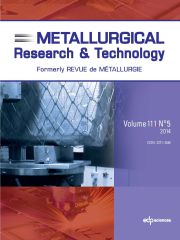Article contents
Refining high-silicon hot metal in an oxygen converter. Newprocess to decrease slopping and fume emissions
Published online by Cambridge University Press: 18 January 2011
Abstract
The recent decrease in Blast Furnace production as well as changes in raw materials andprocess conditions has produced an increase in the silicon and phosphorus contents in hotmetal. This situation increases the probability of slopping and fume emissions duringconverter blowing because of the large volume of highly viscous slag. To carry out thesilicon oxidation and dephosphorization steps, a double slag practice has to be used. Thefirst slag is rich in silicon and phosphorus and has a low basicity. The first slag isremoved. Then the second slag is formed; this low-viscosity slag is subject to the strongagitation created by a high decarburization rate. The second slag is characterized byhigher CaO and phosphorus contents. These conditions yield a better dephosphorization atthe end of the blow. In order to implement the double slag practice, the converter controlsystem was modified. The changes included the design of the lance blowing pattern, theflux additions, the static control, and the logic of the gas collection and cleaningsystem. For a silicon content larger than 0.60% in the hot metal, the results show asignificant reduction in the fume emissions and in slopping, a lower flux consumption, andopen up the possibility of working with iron ore with higher phosphorus content.
Keywords
Information
- Type
- Research Article
- Information
- Copyright
- © EDP Sciences
References
Références
- 2
- Cited by

